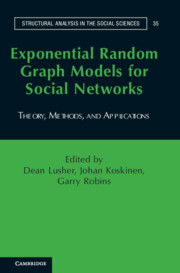Book contents
- Frontmatter
- Contents
- List of Figures
- List of Tables
- 1 Introduction
- Section I Rationale
- Section II Methods
- 6 Exponential Random Graph Model Fundamentals
- 7 Dependence Graphs and Sufficient Statistics
- 8 Social Selection, Dyadic Covariates, and Geospatial Effects
- 9 Autologistic Actor Attribute Models
- 10 Exponential Random Graph Model Extensions: Models for Multiple Networks and Bipartite Networks
- 11 Longitudinal Models
- 12 Simulation, Estimation, and Goodness of Fit
- 13 Illustrations: Simulation, Estimation, and Goodness of Fit
- Section III Applications
- Section IV Future
- References
- Index
- Name Index
11 - Longitudinal Models
Published online by Cambridge University Press: 05 April 2013
- Frontmatter
- Contents
- List of Figures
- List of Tables
- 1 Introduction
- Section I Rationale
- Section II Methods
- 6 Exponential Random Graph Model Fundamentals
- 7 Dependence Graphs and Sufficient Statistics
- 8 Social Selection, Dyadic Covariates, and Geospatial Effects
- 9 Autologistic Actor Attribute Models
- 10 Exponential Random Graph Model Extensions: Models for Multiple Networks and Bipartite Networks
- 11 Longitudinal Models
- 12 Simulation, Estimation, and Goodness of Fit
- 13 Illustrations: Simulation, Estimation, and Goodness of Fit
- Section III Applications
- Section IV Future
- References
- Index
- Name Index
Summary
Network Dynamics
Like all things in the world, networks are subject to change. Sometimes researchers observe networks at one point in time – this is often called a “cross-sectional observation of a network.” At other times, researchers make repeated observations of a network where the node set remains the same but ties may change – this can be called “longitudinal or dynamic network data.” Although the data collection requires more effort, there can be an important payoff because dynamics often tell us more about what governs social behavior than a cross-sectional view. This chapter presents a natural extension of exponential random graph models (ERGMs) to the longitudinal case.
Data Structure
A finite number of observations on a network of the same relation on the same node set (e.g., collaboration among the employees in a firm) is called a “network panel data set.” Such a data set may be denoted by X(t0), X(t1),…, X(tM−1), where X(tm) is the adjacency matrix representing the network at observation moment tm, and M ≥ 2 is the number of observation moments. On all observation moments, we have the same set of n actors, but the ties between them may be different. The question treated in this chapter is not how to explain, or model, each network X(tm) by itself, but how to model the changes from X(tm) to X(tm+1), for m = 0,…, M.
- Type
- Chapter
- Information
- Exponential Random Graph Models for Social NetworksTheory, Methods, and Applications, pp. 130 - 140Publisher: Cambridge University PressPrint publication year: 2012
- 2
- Cited by

